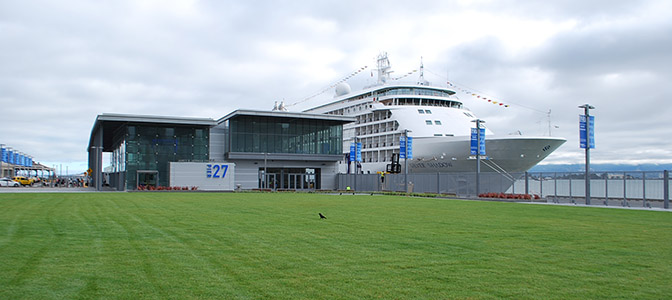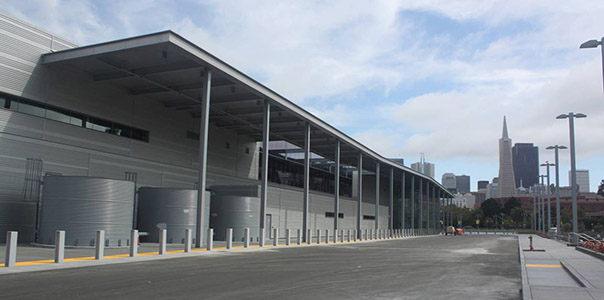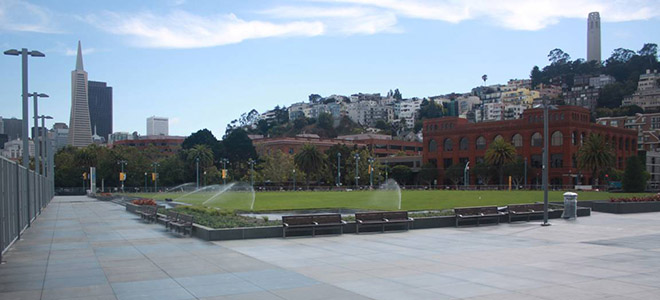On September 18, cruise ship passengers filled the halls of San Franciscoís new Justin R. Herman Cruise Terminal at Pier 27 for the very first time.

Many green elements at the new Justin R. Herman Cruise Terminal at Pier 27 have earned the facility a LEED Silver certification including optimal use of natural light radiating off the Bay, low-flow toilets and energy-efficient light fixtures, a comprehensive waste management system and an eco-friendly pest management system. Photo by Joel Williams
By Bill Picture
Published: October, 2014
On September 18, cruise ship passengers filled the halls of San Francisco’s new Justin R. Herman Cruise Terminal at Pier 27 for the very first time.
In preparation for that big day, the team responsible for the design and construction of the project—a collaboration between the Port of San Francisco, the San Francisco Department of Public Works (managers of the project), sustainability advisors Brightworks, architects Kaplan, McLaughlin & Diaz, and Pfau Long Architecture—were busy until the very last minute putting the finishing touches on the 70,000-square-foot terminal and its adjacent acres of waterfront public space.
Green elements have earned the facility a Leadership in Energy & Environmental Design (LEED) Silver certification from the United States Green Building Council. “Sustainability is something we now strive for with every project,” said Dan Lum of architecture firm Kaplan, McLaughlin & Diaz. “It’s a proven best practice, so it’s practically become the norm for us. We as architects are aiming to create the most sustainable spaces possible, regardless of LEED certification. That’s the icing on the cake.”
Don’t be fooled by Lam’s nonchalance. It’s true that LEED certification is required by San Francisco for all new large construction projects. But San Francisco’s bar is high even for California, which has the most stringent statewide green building standards in the country. “Here in California we have CALGreen requirements that make it really easy for a new building to earn its LEED stars,” said Jesus Bendezu, a sustainability advisor at Brightworks.
Let it rain
Instead of using showy green elements that draw attention to themselves, the cruise terminal’s design team has found a way to make environmental responsibility seem like par for the course.
An important feature of the new and improved Pier 27 is its rainwater harvesting system. Diverting water from city storm drains that lead to the San Francisco Bay is a big deal regardless of where you are in San Francisco, but waterfront properties like Pier 27 find themselves situated at the very front lines of the battle to protect the Bay from stormwater runoff.
Rather than allowing water to run off the new cruise ship terminal and across adjacent concrete spans, picking up pollutants along the way and depositing them in the Bay, Pier 27’s design team found a solution. Rainwater at the site is captured and held in five 42,000-gallon tanks, then used in flush toilets inside the terminal and for irrigating landscaped areas. (Worry not, potty-bound terminal visitors, there is a backup plan—traditional running water flowing to those toilets in case there’s not enough rainwater.)
“Of course, with this drought that we’re experiencing, rain is a problem we’d all love to have,” said Bendezu. “And the grass we selected for the outdoor spaces was chosen because it’s drought-friendly.”
The construction of the building was also green from the ground up. The project boasted a 95 percent construction waste diversion rate, meaning that 95 percent of the waste generated during construction was recycled or reused, and the overall building was constructed of more than 25 percent recycled materials.
Other green design elements at the terminal include: optimal use of natural light radiating off the Bay, the usual low-flow toilets and energy-efficient light fixtures, a comprehensive waste management system, a green tidying program using only the most environmentally friendly cleaners and an eco-friendly pest management system.
“But none of it is anything sophisticated that we can really brag about,” said Lum. “I mean, these are all tried and true approaches to building design now.”
That’s so last year
The real nuts and bolts of the new Pier 27 were completed last year prior to America’s Cup, whose organizers set up their home base there. When the race ended and organizers packed up and cleared out, the design and construction teams resumed their work to help the property realize its true full potential.
The goal was then to help Pier 27 transition from a sports venue into the sleek and sexy cruise ship stop that the folks at the San Francisco Port Commission had envisioned. A few years ago, the commission decided that a new terminal was needed to replace cruise ships’ former port-of-call at Pier 35, which couldn’t accommodate today’s huge vessels.
“The majority of what we’ve done since America’s Cup is complete the site work,” said Lum, referring to the terminal-adjacent open spaces, which are all accessible to the general public. “America’s Cup needed a lot of flexibility in terms of how they used the space, so the hard-scaping [concrete work] was done, but not much beyond that.”
Interior spaces have also been built out. For instance, U.S. Customs and Border Protection had specific requirements for agents processing the long queues of incoming cruise passengers.
Still, the continued duality of the space was a goal for its designers. With it occupying a prime piece of waterfront property with spectacular views of several of the items on every San Francisco visitor’s bucket list, it would be a shame if the James R. Herman Cruise Terminal were to sit completely idle between cruise ship arrivals. So the space, with an open floor plan that can be configured to suit just about any event from an intimate wedding to a corporate conference, is being made available for rent to would-be hosts.
“It’ll be exciting to see the different ways that Pier 27 gets used over the coming years,” said Lam. “As an architect, you come to think of every project as yours, and it’s exciting to hand it off at the end to its actual owners—in this case the people of San Francisco.”
For more information on the new James R. Herman Cruise Terminal at Pier 27, visit the San Francisco Port Commission’s website at www.sfport.com.

Rainwater at Pier 27 is captured and held in five 42,000-gallon tanks, then used in flush toilets inside the terminal and for irrigating landscaped areas. Photo by Dan Lum

Even the grass selected for the outdoor spaces was chosen because itís drought-friendly reducing the need for watering. Photo by Dan Lum

